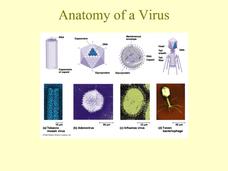Bozeman Science
Integumentary System
You will shed approximately 40 pounds of skin cells in your lifetime—wow! Scholars first learn about the multiple functions of our skin, both the epidermis and the dermis, and its role as a covering for the human body. The video then...
Curated OER
genetics
Parts of the cell as well as genetic material begin this presentation. As the slides continue, there are explanations of the main terms used in genetics. The structure of genetic material, chromosomes, and replication are summarized....
Bite Sci-zed
DNA and RNA, A Nucleic Acid Primer!
Every single cell in the human body is packed with genetic material! A video presentation provides a thorough overview of the components of this genetic material. An engaging instructor defines DNA and RNA and discusses its structure and...
TED-Ed
What Happens When Your DNA Is Damaged?
Did you know that your DNA can be damaged tens of thousands of times per day? Learn about the ways that damage to just one strand of your DNA can be fixed, or in extreme examples, result in genetic mutation such as cancer.
Crash Course
Meiosis: Where the Sex Starts
The narrator of a short video walk scholars through the beginning steps of meiosis, details how the steps are similar to the stages in mitosis, and then points out the very specific differences in meiosis that for variation within...
Teach Engineering
How Antibiotics Work
Take two pills and call me in the morning. The first lesson in a short unit of four introduces class members to delivery methods of medicines. The instruction introduces the question of which delivery method is best to get you feeling...
Teach Engineering
Microfluidic Devices and Flow Rate
When you have to flow, you have to flow. The lesson introduces class members to microfluidic devices and their uses in medicine. They watch a short video on how the diameter affects the rate of flow. The worksheet has individuals...
Kurzgesagt – In a Nutshell
How Small Is An Atom? Spoiler: Very Small
The hydrogen in your body is exactly the same as the hydrogen in the sun. The video explains just how small an atom is and offers comparisons, such as the one above, to help facilitate understanding. It also presents the current model of...
Howard Hughes Medical Institute
Human Chromosomes
Learn a little about what makes humans unique. Young scholars view a video lesson as an introduction to chromosome pairs. Images show pairs of chromosomes including the XX or XY sex chromosome combinations.
Curated OER
Anatomy of a Virus
This PowerPoint summarizes details about the virus from the structure and reproduction methods to the different modes of infection. Various viral diseases of animals and plants, viroids, prions and genetic origins of viruses are discussed.
Stated Clearly
What is DNA and How Does it Work?
Discussions of DNA occur in Jurassic Park, X-men, Dexter, and CSI, yet many don't fully understand it. The video explains what DNA is, where it is located, and how it forms proteins. The chemistry of life becomes understandable through...
Crash Course
Supreme Court of the United States Procedures: Crash Course Government and Politics #20
How can you get a case argued before the Supreme Court of the United States? Learners research the way a court case ends up in the highest court in the 20th installment of a 50-part series covering the United States government and...
PBS
Photosynthesis | UNC-TV Science
Discover what links photosynthesis and food chains together. Scientists explore the basics of photosynthesis, including its products, during an animated activity. While watching the video, investigators also learn the importance of sugar...
Curated OER
Bacteria
There is an important distinction between the bacteria that most students recognize as having a negative impact, and those that live in a symbiotic relationship with us. Sal looks at the mechanisms by which bacteria accumulate variation...
Curated OER
DNA Replication
After viewing this presentation, students create a complete set of notes to support their learning of DNA replication. Each slide has information on a step in DNA synthesis process. The slides focus primarily on the processes rather than...
Socratica
What Is Biochemistry?
Watch as chemistry comes alive! Socratica's biology playlist kicks off with a simple video detailing the principle components of biochemistry. Content includes carbohydrates, proteins, and nucleic acids. The narrator describes each class...
Curated OER
Muscles and Motor Locomotion
This is a fabulous presentation which should reinforce all aspects of muscle construction on a gross anatomical and micro level. There are slides to help understanding with the muscle fiber anatomy, and many labelled diagrams to explain...
Curated OER
Circulatory Systems
A slideshow that covers the all-important details related to basic human circulation. The reasoning for exchange of material methods is presented and then labeled diagrams of the main human transfer systems are shown, along with...
Curated OER
Advanced Genetics
Are your biologists ready for advanced genetics? Briefly learn about Gregor Mendel, and dive into the phylogenetic tree, linked genes, multiple genes and nonnuclear inheritance! Mr. Anderson continues his clear instruction and use of...
Khan Academy
DNA
The picture of the DNA double helix provides a logical start to describing how the base pairs match up and how the order codes for a chain of protein molecules. Three billion of these base pairs code for any protein present in your body....
Howard Hughes Medical Institute
Great Transitions: The Origin of Tetrapods
The featured movie focuses on the ancestry of our four-footed friends. Find the fundamental pattern of their limbs and vertebrae in fossils of fish. After viewing, biology learners can enjoy interactive websites to zoom in on the...
Curated OER
Lipids: Fats and Oils
A fantastic presentation with great images should improve student understanding of lipids and their involvement in the body. The chemistry of different fats, phospholipids, and steroids are explained. Additionally, the specific uses,...
Curated OER
Lipids: Fats and Oils
A fantastic presentation with great images should improve student understanding of lipids and their involvement in the body. The chemistry of different fats, phospholipids, and steroids are explained. Additionally, the specific uses,...
Curated OER
Transport in Plants
Quite a detailed and advanced look at the transport mechanisms of a plant. The absorption and control of sugar and water concentration are explained and will help an understanding of homeostasis concepts and organ specialization.
Other popular searches
- Plant Cell Biology
- Inquiry Based Cell Biology
- Cell Biology Mitosis
- Cell Structure Powerpoint
- Cell Biology Meiosis
- Cell Structure and Function
- Cell Biology Vocabulary
- Label Cell Parts
- Grade 11 Cell Biology
- Cell Parts Pictures
- Cell Biology Activities
- Human Cell Biology

























